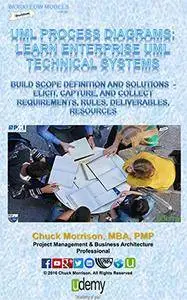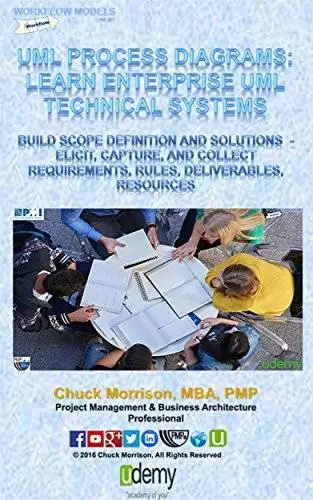UML Process Diagrams: Learn Enterprise UML Technical Systems: Build scope definition and solutions - Elicit, Capture, and Collect Requirements, Rules, Deliverables, Resources by Chuck Morrison
English | 30 Jul 2016 | ASIN: B01JEQXO80 | 126 Pages | PDF (True) | 3.48 MB
English | 30 Jul 2016 | ASIN: B01JEQXO80 | 126 Pages | PDF (True) | 3.48 MB
Management is all about balance, communication, collaboration, adjustment, and consensus as requirements are discovered, captured, executed, tested, and delivered. To prevent one class of requirements from over-riding another, constant communication and collaboration among members of the project, development, test, and delivery teams is crucial. For example, in software development for internal applications, the business has such strong user requirements needs that may be ignored, or believe while creating use cases, the user requirements are being taken care of when these are not expressed, captured , defined, and documented. This can lead to missed requirements, expectations or project failure.
The purpose of Requirements management is to ensure project requirements meet business needs and expectations as inconsistencies are identified among those requirements supported by project plans ensuring work products delivery. Further, requirements management practices must include change management and traceability.
What is a Requirement? A requirement is a measurable action or set of actions a system must do (behaviors and functions). It may also be a measurable quality or property a system must have (attributes and persistence). Requirements must capture what is needed to satisfy client business processing needs and expectations in delivered systems. Requirements are categorized as three types: Functional, Non-functional (Performance), and Constraints. Issues are used to define risks involved in meeting requirements. Work Inventory is a collection of all completed and non-completed work and issues.
Requirement Types
• Functional
• Non-Functional
• Constraints
• Issues
• Work Inventory
Take action today and learn "UML Process Diagrams: Learn Enterprise UML Technical Systems" by downloading your Kindle book today at a limited time discount of only $2.99.
Summary
UML Models are typically used by business analysts and architects because its rich language is useful for modeling application structures and behaviors needed to support business process requirements and solutions.
Although UML 2.0 provides 14 UML diagram types, only the most useful for business modeling are discussed during this course. The balance are found in references provided in concluding course lectures and documents. As students, you are encouraged to explore our course glossary and references as desired and needed.
Download this book now to learn:
• Provide functional requirements capturing tool. To answer this question, we’ll first discuss “What’s a Requirement”? …
• Decompose stories into requirement statements to identify Use Cases representing Functional and Non-Functional Requirements supported in a Work Breakdown Structure.
• Give those responsible for designing, building, and/or buying solutions the kind of information they need to make the right decisions for the business.
• Identify system behaviors, actors, pre-conditions, post-conditions, relationships and constraints based on well-defined use cases and user stories used to define functional and non-functional requirements.
• Document and manage Business system, Stakeholder, Functional, Non-Functional, and Data requirements.
• Capture and clarify Business Rules and External Constraints that mandate limits to delivered solutions.
• Develop measurable Solution Requirements facilitating End-User Acceptance Testing and delivery.



